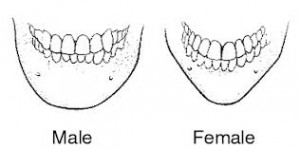
Narrowing of the chin or front part of the lower face can be done by several methods, all of which require bone reduction. If a chin osteotomy (osteoplastic genioplasty) is being done, the width of the chin will naturally narrow when the chin bone is brought forward and/or vertically lengthened. But not everyone needs horizontal or vertical chin lengthening so an osteotomy can be ineffective. The other approach is direct burring reduction of the chin or mandibular tubercles. By reducing the bony sides of the chin it can be narrowed in the frontal view.
When doing an osteotomy to create a chin narrowing effect, it is important to realize that the bone will not narrow behind the osteotomy cut. This also is where a step-off can be created at this junction which is most evident when horizontal advancements are done. As the bone edge of the downfractured chin segment moves forward, this step-off can be created. It can be a difficult area to reach for smoothing out this step-off and there is risk to the mental nerve which is very close by. This is why it is helpful to make that osteotomy cut back as far as possible to extend the natural narrowing effect of the advancing osteotomy and avoid a prominent step-off.

To achieve a more slim feminine lower face, reduction of the jawline must be considered as a whole. Changing the width of the chin from a more square to a tapered shape creates an essential change in the frontal view. Barring the need for horizontal or vertical lengthening of the chin, burring or saw reduction of the sides of the chin can be done from either an intraoral or submental approach.
Dr. Barry Eppley
Indianapolis, Indiana


